
Our History
18
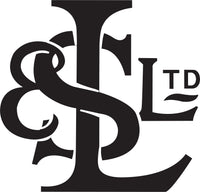
World famous Hawick knitwear
The town of Hawick nestles in a picturesque valley amongst the rolling border hills and remains to this
day a charming, traditional Scottish small-town. It lies at the confluence of the Rivers Slitrig and
Teviot, 15 miles (24 km) from the cheviot hills and the English border. The knitwear industry has long
been central to the town’s economic success.
The crystal-clear waters and hillside landscape of the Scottish borders created the perfect conditions
for knitwear production. In the centuries prior to Lyle & Scott’s foundation, wool from the sheep that
grazed the lush grass would be washed and readied for knitwear production.
The origins of a knitwear industry emerging in Hawick can be traced back to 1771, when a merchant from
the west of Scotland, Bailie John Hardie, introduced stocking frames that increased the speed of hand
knitted production. Water and steam powered machinery soon followed, along with rail transport in 1849.
These opened Hawick’s export capabilities, first to Carlisle over the English border and further afield
from there.
Thanks to these significant developments in knitwear production throughout the 18th and early 19th
century, Hawick had become an internationally recognised production source for high quality knitted
garments by the 1870’s.
In 1874, two locals with experience in the knitwear industry would go on to further establish Hawick’s
reputation by opening their own factory, manufacturing hosiery and underwear.

Our factory in the middle of Hawick, Scotland.
A tale of two families
William Lyle & Walter Scott worked in the Hawick hosiery trade into their 40s before deciding to step
out on their own forming what came to be known as Lyle & Scott in the latter part of 1874. The two men
secured a bond & disposition to feu land for the factory with a warrant of registration for the company
taking place on the 8th September 1874 . They settled on the name and logo ‘Ellan-ess’, a play on the
first letters of their last names when pronounced with a broad Scottish Borders accent.
Despite their experience, neither man could have predicted the astonishing success their firm would
have.
Armed with Walter Scott’s motto "Good work means more work" and William Lyle’s successes selling on the
road, Ellaness quickly began to generate commercial revenue. Within a few year the company was
supporting a rapidly expanding market and delivering quality garments to the major wholesale warehouses
in the largest cities around Britain.
The founding duo continued to break ground and expand up until 1889, when William Lyle took an
unexpected step back from the business, before returning in 1892 to take back the reins from Walter
Scott following his sudden death. The details of Walter Scott’s life are scarce, but his character and
influence on the early years of Lyle & Scott can still be seen today with his motto frequently
referenced in Lyle & Scott’s head offices.
William Lyle’s return was accompanied by Walter Scott's two sons - William and James - who between them
shared the management responsibilities. A year after their father's death, they decided to install
powered machinery to speed production and meet the increased demand for their products, which included
the now famous Ellaness woollen underwear.
Growth continued in the late 19th century and the firm was converted into a private limited company in
1897. William Lyle was appointed Chairman and Managing Director, a post he held until his death in 1903.
At this point, the third great family to influence the early years of Lyle & Scott rose to significance:
long serving Secretary Robert Oliver took on joint management responsibilities with John P. Scott, son
of the founder.

Our founders, William Lyle and Walter Scott.
19
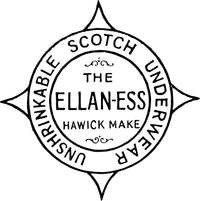
The Jubilee years
Over the next twenty-five years, and in the build up to the 1924 jubilee, the stability for long term
success was cemented. The Great War created a turbulent global landscape, as well as significant
socio-economic difficulties on home soil. Unfortunately, Robert Oliver passed away two years before the
jubilee celebrations, but the work done by management throughout this period did not go un-noticed by
their workforce.
The strong bond between workers, management and the firm were clear throughout the jubilee celebrations,
with an event held in nearby Selkirk to commemorate fifty years in business. The success of the event is
well documented, with local newspaper coverage calling out the highlights of the presentation of the
illuminated address to John P Scott, the motor run and picnic and a speech from the oldest employee at
the time. Mr George Mitchell’s speech paid homage to the courage and integrity of the founders, as well
as the untiring energy of the late Mr Oliver and J. P. Scott for piloting the firm through the
commercial & financial post-war crises.
In the years after the war and jubilee, several traditions were established that would set the brand up
for the century ahead. A reputation for quality and pride of production, coupled with a close working
relationship throughout the business, became the foundations for continued success. The story of Lyle &
Scott began to spread throughout the world thanks to the work of John P. Scott and later Charles Dixon
Oliver - son of Robert Oliver - in the decades to come.
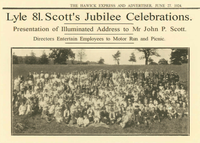
The company celebrating it’s Jubilee in 1924, with a group outing.
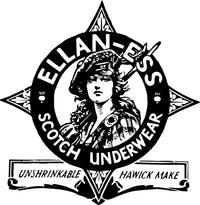
Charles Dixon Oliver
Originally joining as a young apprentice in 1911, C. D. Oliver became a decorated war hero, earning a
military cross for his efforts in the war. He returned to Hawick filled with ambitions to make a name
for himself in the rapidly developing world of knitwear. In 1926, his ambition was rewarded with a
promotion from Salesman to Director, his new board members considering it a “mistake to lose his
services” to a rival firm.
C. D. Oliver immediately alerted the board to the decline of the traditional underwear market that had
been integral to the first fifty years of business, persuading them to pivot production to include
knitted outerwear for the first time. The first years of this new range demonstrated great success until
the Great Depression reversed the robust growth that had come from diversification.
John P Scott sadly passed away in 1935, coinciding with the end of the economic downturn, resulting in
the promotion of C. D. Oliver to Managing director. Turnover doubled in his first two years in charge
and the success of the next three decades would be largely down to the actions of the new Managing
director.
The legacy of Charles Oliver goes beyond commercial success: he retired with fifty years of service to
Lyle & Scott and family ties lasting half of the company’s current existence. His company loyalty, his
determination to battle against adversity along with his frequent praise and respect for his labour
force continue to align with the work ethic of Lyle & Scott’s employees to this day.
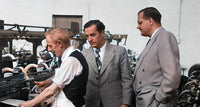
Charles D. Oliver (centre), appointed to Managing Director of Lyle & Scott in 1935.

Diversification
In 1938, having returned the business to stability, Mr Oliver boldly signed a franchise agreement with
Coopers of Wisconsin to become producers of the Y-front for the UK, France and Holland in a deal that
reinvented Lyle & Scott’s underwear business.
Moving away from traditionally knitted underwear to the cut-and-sew construction and cotton composition
of the Y-front was met with displeasure from traditionalists. “Many predicted the collapse of Lyle &
Scott when we commenced production Y-fronts at 27s 6d per dozen” remarked Mr Oliver, who had made a
career of trusting his instincts and seeking new market expansion when the time was right.
Initial growth was limited by the breakout of World War Two, with factory production shifting focus to
support the war efforts. However, in the five years that followed the war, sales increased by 400%; it
wasn’t long before demand was outstripping production capabilities. To cope with soaring sales, new
factories were opened in Gateshead and Dunfermline that were dedicated solely to the production of
Y-fronts. At its peak, output grew to 120,000 pairs per week.
Y-fronts may have been considered a commercial success, but they were not considered the most glamorous
of production lines. While the knitwear range continued to be highly successful, garnering a growing
international following, it was the next venture of Charles Dixon Oliver that would send shockwaves
throughout the knitwear industry…
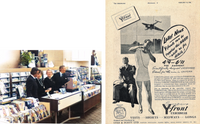
Left: Lyle & Scott concession store. Right: Early Lyle & Scott advertisement of Y-Front underwear.

Fashionable 505
Charles Oliver’s next major coup of his career was to secure a knitwear collaboration with Christian
Dior, the world’s top fashion expert. The coming together of two powerhouses from differing worlds is
captured perfectly by the two leading men of the time, with an announcement made to a packed press
conference in London in May 1954:
“In the international field of fashion today, there is one name that stands supreme – a personality, I
think I may say, on whom the world waits with bated breath. That name and that person is Monsieur
Christian Dior – and it is therefore with no small sense of pride that I am today able to announce a new
business association between that Gentleman and this old established company of ours…”
“The name, no less than the product, is magic. Now with the genius and reputation of Monsieur Dior, I
think we shall have a double spell of magic of the most potent kind, which should prove well-nigh
irresistible”, Oliver delivered proudly to the excited crowd.
“Good taste in dress has an international language of its own, and although Mr Oliver and I may have
mystified each other at times with our respective accents, I am proud to be associated with a venture
which, undoubtedly, will make an added contribution to the export trade of your country”, Mr Dior added
in agreement.
A total of four cashmere collections were produced by Lyle & Scott for Christian Dior. The collaboration
established the brand as a household name in Women’s fashion across North America by appearing in luxury
department stores like Bergdorf Goodman. Collaborations with the likes of Burberry and Michael Kors came
in the years that followed, paving the way for recent partnerships with Junya Wantanabe, Universal Works
and Malbon Golf.
North America was a market Oliver had identified to have enormous long term export opportunities and
made this a constant target to grow the company. Oliver’s willingness to frequently travel to North
America and his unashamedly British style ensured long lasting success by creating valuable
relationships with his humble charm; his rolled-up umbrella and bowler hat turned heads and initiated
engagement wherever he visited. Oliver was able to endear himself to customers around the globe and, as
a result, business boomed.
In 1956 after continued commercial success, an unknown bidder began offering over-the-odds prices to
acquire shares from ordinary shareholders in a bid to take over the company. A legal battle ensued, with
Mr Oliver spearheading the ownership defence of the company he had worked so hard to grow. His refusal
to give in was eventually rewarded with victory in 1958, but the business landscape was beginning to
change.
Despite the continued growth and popularity of the company’s products, the legal battle had been costly
and external investment was required to further develop the global interests of the business. In 1964,
the company was taken over and Mr Oliver retired leaving a legacy beyond even his wildest ambitions.
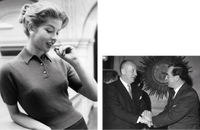
Left: A Dior design by Lyle & Scott. Right: A handshake between Christian Dior and Charles D. Oliver.

A Royal Relationship Begins
In July of 1962, shortly before Mr Oliver’s final year, H.M Queen Elizabeth II and H.R.H The Duke of
Edinburgh attended a fashion show which featured three Lyle & Scott models. The Queen sat next to
director Bill Kyle, who talked her through the finer technical points of the garments on display. Both
royal attendees were seen to enjoy their day, giving thanks to the models for their performances.
The 60s was a decade of change for Lyle & Scott as they worked towards the centenary of the company in
1974. One hundred years of British knitwear craftmanship was recognised with the appointment of a Royal
Warrant from H.R.H The Duke of Edinburgh. The appointments of Royal Warrants date back to the 15th
century, being granted to companies that regularly supply goods or services to the Royal household.
A fantastic achievement for the company and a proud moment for all who have been associated with Lyle &
Scott, the warrant was granted to Bill Kyle twelve years after their first meeting.
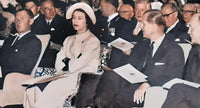
H.M.Queen Elizabeth II and H.R.H The Duke of Edinburgh visit Hawick, attending a fashion show in July 1962.

Golfing Greatness
The change of management represented a shift in the businesses operative. The golf market boomed in the
early 60s and presented a perfect opportunity: While every day fashion continued to modernise and move
away from the conventional norms of the prior decades, golf style had become established as a mix of
casual and classic with a heavy dependence on knitwear.
Up until this point in Lyle & Scott’s history, the use of logos had been limited to advertising and
garment labels, but brand identification was becoming more popular to customers to highlight the quality
and status of apparel being worn. Logos for Ellaness and Lyle & Scott products existed, but these didn’t
quite represent the needs of a sporting consumer. The clothing worn by golfers had begun to carry motifs
- rather than scripted text logos - of their manufacturers, and so Lyle & Scott commissioned the
now-famous Scottish Golden Eagle .
The Golden Eagle holds great relevance as a brand logo, especially in the golfing world. As well as
being the golfing term for when a player makes a hole in two shots below par, Golden Eagles are native
to Scotland. The company and the bird of prey also share characteristics: the courage, bravery and
determination by Charles Oliver and a pride for quality and reliability that comes from years of
experience producing high quality garments. The Golden Eagle emblem was immediately registered as a
trademark, creating an easily recognisable symbol for use worldwide.
With years of experience in high quality knitwear and a powerful logo, Lyle & Scott would quickly begin
to ruffle some feathers within its new market. Lyle & Scott attended its first Open championship in
1968. Competitors, having had the golf market all to themselves for years, did not take kindly to the
appearance of Lyle & Scott, so much so that they rallied to remove the company from the event. A
connection was formed with a well-known and respected trade name Alf Owen (Manchester), who acted as an
agent for Lyle & Scott’s product, enabling market entry and creating the platform that would take the
company to the new heights over the next thirty years.
Success came quickly but, as this first foray at the Open has proved, the market was close knit, highly
competitive and undergoing a period of innovation. At the time Lyle & Scott had over eighty years of
experience and confidence in its ability to lead on innovation, following successes in fashion,
underwear and production techniques in the formative years of the company. The approach to golf was no
different from those that came before.
Having quickly adapted sales techniques to tour products around Scotland’s top golfers and courses, Lyle
& Scott lead a change in the market by dressing two top British Ryder cup golfers. Malcom Gregson and
Bob Huggett, both of whom remained in golf their entire careers, recording over 40 professional wins
between them. The professionalism of both players on and off the course further established the
reputation of Lyle & Scott and began to synonymise golf and the company’s name.
With the help of the media, golf was rapidly gaining popularity, and new markets opening worldwide. Lyle
& Scott were quick to embrace these new markets, becoming the number one golf brand in Sweden and Japan.
As the game grew, so did the products on offer from Lyle & Scott: shirts were added to the range, then
trousers, socks and a full range of accessories.
Lyle & Scott's achievements were soon to extend to its roster of professionals. In 1978 Jack Nicklaus,
the man arguably considered the greatest golfer of all time, became the first player to win a major
tournament wearing garments produced in a Lyle & Scott factory. The iconic images of this win at St
Andrews, just an hour from the Dunfermline-based Lyle & Scott factory, show the golfer sporting a navy
argyle v-neck.
In 1986, Lyle & Scott managed another major coup when Greg Norman won the Open at Turnberry and went on
to win a further six tournaments that year, all while proudly wearing a Golden Eagle emblazoned Lyle &
Scott v-neck jumper. Ian Baker-Finch, another Australian, won the Open at Royal Birkdale in 1991 with
the Golden Eagle on his sweater. Other pinnacle moments of this era included supplying outfits for the
Ryder Cup team in 1981 and the Hennessey Cup Team in 1982, which included outfitting some of the best
golfers of that generation including Nick Faldo and Sandy Lyle.
Many professionals of note have worn Lyle & Scott in their careers, including Tony Jacklin, Bernard
Gallacher, Gary Player, Florence Descampe and Lee Westwood. As well as this, Lyle & Scott's name can be
seen in the most prestigious club shops around the world, all of which enables the company to keep its
profile high in what remains a key market to this day.
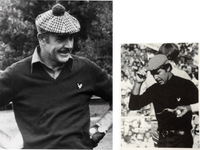
Left: Sean Connery. Right: Gary Player.
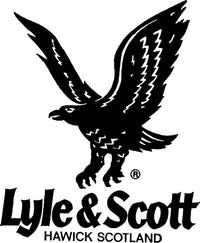
Fashion from the terraces
In modern times, a more complicated global landscape has proven to be an inspiring backdrop for iconic
moments in art and culture. With modern media becoming more accessible from the 60s onwards, these are
documented and looked back on with fondness. Whether these moments relate to sports, fashion or music,
the last sixty years continue to inspire the creatives of today.
Fashion and football had intertwined before the 80s with teddy boys, mods and skinheads all prominent
crossovers of passion. These movements paved the way for what came next: Casuals, an era of football and
a type of supporter that became notoriously fashionable and dangerous in equal measure.
Inspired by their subcultural forebearers, an integral part of Football Casuals was European sportswear,
which allowed their endeavours on and off the pitch to take place in a stylish and functional manner.
The legacy of this subculture can be seen littered across the next twenty years of classic British
music. Post-punk, acid house, brit pop and indie all rose to prominence alongside labels and brand names
worn by their fans, all gaining cult status like never before. Motifs like the Golden Eagle quickly
emerged front and centre as an essential part of a Casual’s uniform.
Picking up Lyle & Scott garments from the now vast golf range, the football terraces became as a second
home for the Golden Eagle. With a wide-ranging audience that conquers age and gender demographics,
football is integral to modern-day Lyle & Scott by influencing the collections and campaigns they
deliver today .
The legacy of this era remains at the forefront today. Every Saturday fans continue to proudly wear
their best Lyle & Scott on match days, and we are proud to be a product of the universal language that
comes with a passion for football. The legacy lives on in fashion through some of the icons of the
movements who continue to make a name for themselves and develop their brands today.


Re-Invention for the millenia
After such a prolonged period of successful commercial ventures, the 90s came and with it an
ever-changing world to keep up with. Sustained success continued in the golf market, but with the
emergence of the internet, new media and hundreds of new competitors the necessity for re-invention
became apparent to anyone who hoped to remain a major force in British fashion. After a period of
uncertainty, Lyle & Scott’s re-invention began in 1999.
The company began to update its image, a fresh approach saw the company strategically blur the lines
between golf and lifestyle. By using younger models in stylised settings, the golf range was showcased
in a new light, marking a move towards market products to be worn off the course. Despite not
immediately being rewarded with financial success, this change in tack would be the catalyst for bigger
change to come.
After a decade of difficult trade, Lyle & Scott’s ownership changed hands and the revolution began with
a head office relocation to London and a letter to the press announcing a rebrand. The brand returned to
private ownership and with it came a renewed sense or purpose. New owner Sue Watson brought a vision for
success built on the foundations of strong leadership and bottom up accountancy. In similarity to her
predecessors, an acute awareness of the right time for change and re-invention would enable the brand to
go from strength to strength over the next two decades.

20
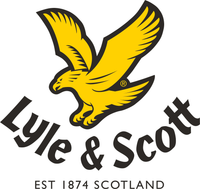
Another Era
Beginning with another era of diversification, the product ranges split into four: Cashmere, Generic,
Golf and Vintage. The new ranges would serve a different purpose with specific target audiences. Golf
would continue to cover sports lifestyle with technical fabrications for performance on the golf course
whereas cashmere would continue the legacy of British production using traditional techniques for the
luxury market. Generic would cover classic knitwear for the European market, but it would be the Vintage
range that would take the brand to new heights.
The range was designed to represent the edgy side of the brand, using retro designs and a tagline of
‘Establishmental’ to subvert the brand’s norms. Launching at Autumn Winter 2002, with its first full
range in Spring Summer 2003, the first collection took inspiration from the colour palette of Dove Grey,
Lemon and White, immortalised by Greg Norman’s 1986 Open win.
The launch of Vintage acted as a catalyst that catapulted the brand back into the fashion spotlight.
Supported by successful marketing campaigns and opportunistic PR work built on musicians and key
celebrity brand ambassadors, the Golden Eagle was back where it belongs, a badge of honour among
twenty-somethings across the UK.
The new strategy was an early adoption of influencer marketing, using the ever-growing popularity of
celebrity culture to generate product desirability and ultimately grow sales. Using bands of the moment
like Arctic Monkeys and Babyshambles, celebrities of the moment like Emma Watson and Holly Willoughby,
alongside football’s elite like Cristiano Ronaldo, the brand was able to ride a wave of immense revenue
growth. This strategy has now become the norm, with social media creating millions of influencers
worldwide, but this campaign and strategy captured a culture-defining moment in Great Britain. Lyle &
Scott’s tradition of being positioned at the front of British youth culture continued.
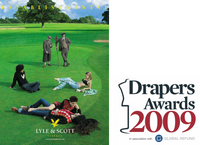
Left: Lyle & Scott “establishmental” marketing campaign. Right: Lyle & Scott Drapers Award Winners 2009.
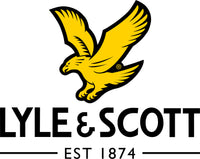

Foundations for the future
Often the best stability can be sought from the lessons of the past. At a point of stagnation in 2013,
Lyle & Scott found themselves at a crossroads: sustain themselves as a mid-market British fashion
brand or adapt to keep up with developing technological advancements. Over a century of success so far
has been achieved by strong leadership and adaption, and again this was the only suitable option to
take the company to the next level.
A change in management structure included the appointment of the first ever Lyle & Scott CEO. Philip
Oldham was appointed after a recruitment campaign which used social media to target best in class
applicants with a unique and innovative approach to management. Following the appointment, personnel
and systems were recruited to set up for a period of rapid growth. The stewardship of Watson and
Oldham made this possible, the alignment of their varied skillsets made for an inspiring leadership
team that became a catalyst for success. The bravery of the initial overhaul and their quick,
calculated decision making would soon be rewarded with the commercial successes the brand deserves.
Subtle tweaks and developments were made over multiple seasons to expand the brand further across the
world. New collections were created to keep up with a changing world. Sportswear became a mainstay
from spring summer 2016, with collaborations and bespoke collections coming and going to support
specific moments in time. Reliance on the UK for success was diminished by maximising international
relations, spreading and growing sales across the globe. Over a five-year period from 2014, revenue
doubled reaching its highest ever level.

New Lyle & Scott knitwear designs for Spring Summer 2014 collection.
Foundations for the future
Lyle & Scott’s football fashion legacy continues to drive the brand on today. The fond memories of
these crossovers have been revisited and honoured with recent collaborations. Taking place between
2018 and 2021, agreements with three key strategic partners were made to relaunch Lyle & Scott’s deep
routed association with terrace fashion.
Beginning with Italian sportswear giants Diadora. A collection containing shell-suits and footwear,
inspired by Diadora’s history producing Scotland’s national team football kits, were launched with an
editorial shoot celebrating the joys and delinquency of the walk home from school.
Next up was Neal Heard: a football shirt, footwear and Casuals culture obsessive, with a collaborative
knitwear capsule with his brand Lover’s FC. The collections celebrated iconic football shirts from the
past 40 years, re-imagined through crew neck lambswool jumpers and knitted polo shirts.
This was followed by a partnership with Oi Polloi, the Manchester based clothing store that had
become synonymous with Casuals fashion since the millennium. Also taking inspiration from music and
the British culture of the time, the two-part collection focussed on premium mohair knitwear.
Growth continued until 2020, with retail, ecommerce and new business areas developing into valuable
support functions for the established wholesale business. The Vintage and Golf collections continued
to drive the business, and new trend-led collections came and went to supplement further growth.
In early 2020, Lyle & Scott were recognised as one of the fastest internationally growing businesses
in Britain, proving the success of the business pivot earlier that decade. However, the global
covid-19 pandemic hit and businesses were forced into un-chartered territories. Despite the havoc this
caused on global supply chains, Lyle & Scott successfully negotiated its way through challenging
circumstances to emerge with a business in good health, still geared for growth.
The pandemic period presented the opportunity for further evaluation of how best to move the brand
forward and become established as a leading global lifestyle brand. It is part of Lyle & Scott’s DNA
to dream big, and the next chapter would prove no different.
Built on a foundation of quality essential garments, the brand has looked to strategic partnerships to
build on its history in football and golf and develop market-leading initiatives to inspire on and off
the pitch or course alike. With brand ambassadors like Lewes FC, the first club in the world to pay
its men’s and women’s football teams equally, and Rick Shiels, a world leading golf lifestyle
youtuber, there’s a consistent output of content that champions the ethos of the brand that has been
curated since 1874.
The groundbreaking partnerships of the 2010s paved the way for what would come next. In 2023 Lyle &
Scott launched the biggest brand campaign in its history, taking the brand from the football terraces
onto the football pitch. Beginning with a seven-figure investment in the first year, the campaign will
grow to offer new kits to tens of thousands of dedicated grassroots football players all over the
world. The first season of the campaign was overwhelmingly successful, with co-branded football kits
delivered to 1000s of passionate football players across 4 continents, re-establishing the brand as an
inspirational community leader in both football and fashion.
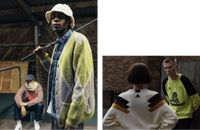
Exclusive capsule collaborations with Oi Polloi (left) and Lover’s FC (right).
Lyle & Scott at 150
150 years after those humble beginnings in Hawick the brand has reached a milestone that very few
others are able to achieve. Having existed and thrived alongside a backdrop of global pandemics and
financial crises, technological evolutions and World Wars, the brand approaches its 150th birthday
stronger than ever. The remarkable achievement will be commemorated with collaborations, events and
archive exhibitions that call on all the experience of this incredible brand history.In 2024, Lyle &
Scott continues to prove that it belongs at the forefront of football, golf and fashion innovation.
With content creation at the heart of the modern world, it’s imperative that the lessons of the past
are considered to create meaningful contributions as we embark on the next 150 years together.
Dare to dream big with Lyle & Scott, it’s within all of us…
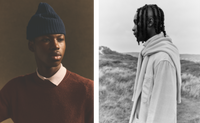

Top: Lyle & Scott Autumn Winter 24 collection. Bottom: Lyle & Scott Kits for Clubs community campaign